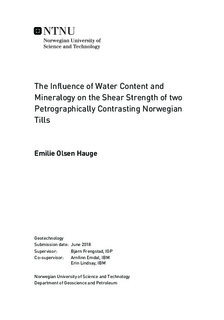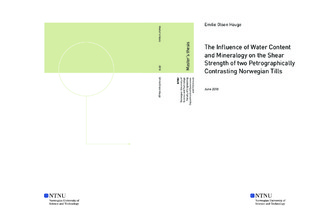| dc.description.abstract | The influence of mineralogical controlled properties and water content on the shear strength of two petrographically contrasting Norwegian till soil types are evaluated within this thesis. A total of ten samples have been collected. Six originating from the Precambrian bedrock region in the county of Møre & Romsdal and four samples derived from the Cambro-Silurian metamorphic rock region in Trøndelag county. Samples have been collected both inside and outside of landslide scars and analyzed in regard to material properties.
Conducted examinations include field investigations, grain size distribution analysis of material finer than 16 mm, mineralogical analysis, shape and angularity analysis and investigation of dry of optimum water content. The results from these analyses were used to explain differences in the shear strength parameters found by conduction of shear box tests on three of the samples. The samples were tested in both dry condition and with a dry of optimum water content.
The angle of friction found by shear box testing ranges from 22.8 to 35.4°. The samples from the valley Innfjorden in the Precambrian bedrock province exhibit in general a higher frictional angle compared to the sample from Gauldalen in the Cambro-Silurian province. Analysis of a limited number of samples imply a connection between the bedrock geology and material parameters, such as particle shape and mineralogy. Furthermore, results from the shear tests indicate an influence of material properties on the shear strength.
The material properties of the samples collected inside and outside of landslide channels show no substantial differences. The only variation is a lower degree of grading of the grains in the samples from inside a channel. In dry condition the samples display the same shear strength properties. When water is added, the out of channel sample exhibits a higher frictional angle.
The change in the shear strength, as a result of added water is not analogous for all the samples. A reason for this might be the different effects of water on the density of the samples. However, the shear stress displacement curves of unsaturated soil show a lower frictional resistance compared to dry material. | |

